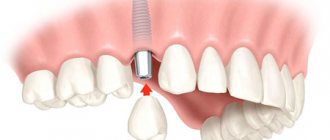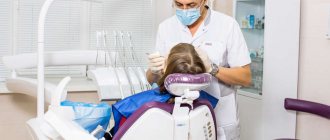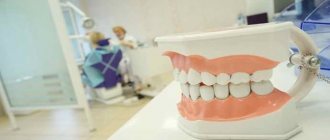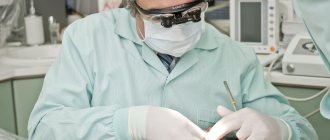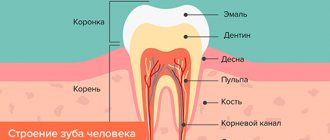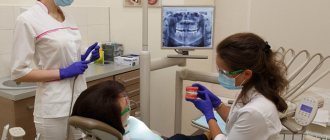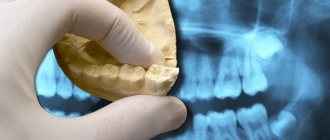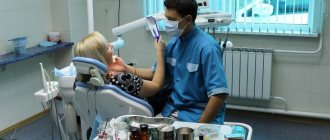- Signs of correct bite
- Types of malocclusion
- Why do you need to correct your bite?
- Until what age can a bite be corrected?
- Ways to correct a bite
- Aligners
- Trainers
- Veneers
- Bracket system
- Types of braces
- Which braces system should you choose?
- How long does it take to correct a bite?
- How to care for braces?
Malocclusion occurs in almost 80% of the Russian population. In a third of cases it requires orthodontic treatment. And it’s not just a matter of aesthetics - if you are often bothered by headaches, earaches and dizziness, then perhaps it’s a malocclusion. An orthodontist deals with the correction and prevention of malocclusions.
The most common misconception about bite is related to age. Many people think that it can only be corrected in childhood, but today, with the advent of new technologies, this can be done at any age.
In this article we will look at the causes and types of malocclusion and why it needs to be corrected. We will also tell you about treatment methods and dispel the most common fears. Orthodontist Olesya Milagina comments on current issues of orthodontic treatment for us.
Signs of correct bite
To begin with, we will show what a normal bite looks like and list the signs by which you can understand that it is normal.
- The main distinguishing feature of a correct bite is the tight contact of the upper and lower jaws when they close. The upper front teeth cover the crowns of the lower ones by a third, that is, the lower incisors come into contact with the palatine tubercles of the upper ones. There is no distance between the upper and lower chewing teeth, and during chewing they are in constant contact.
- Correct bite affects the harmony of facial proportions: the lower and upper jaws are symmetrical.
- There are no speech defects.
- Food is comfortable to bite and chew.
- There is no discomfort or clicking in the jaw joint.
When can you practice biting? And when is it too late?
– Isn’t it too early? – this question is often asked by parents who bring their children to the dentist for their first preventive examination.
- Isn’t it too late? - this is asked much more often, both at twenty and at sixty years old.
So, it is better to consult an orthodontist for the first time when your child is 5-6 years old. That is, at the moment of changing milk teeth to permanent ones. There is little point in coming to the doctor earlier, since even in the case of an existing pathology (for example, due to bad habits, pacifiers or thumb sucking), it is practically impossible to carry out treatment, and it will be ineffective.
But at 5-6 years old, you can already agree with your child that it is necessary to wear a mouthguard or a plate, properly maintain oral hygiene, etc. Not to mention the possibility of correct diagnosis - both impressions and x-rays should be taken at this age much easier.
By the way, about X-ray diagnostics. From the moment the permanent teeth erupt, the child is recommended to undergo orthopantomography once a year. We kindly ask you not to give up panoramic images at such an early age, since the radiation exposure on normal tomographs, like ours, is less than in a two-hour plane flight, but the diagnostic value is incredibly high. Many people do not know that recently, edentia, the absence of a permanent tooth germ (or permanent teeth), is becoming more and more common in children - and in this case, it is fundamentally important to keep the baby tooth healthy and intact for as long as possible.
True, the opposite situation also happens - these are supernumerary “extra” teeth. Sometimes they interfere with the growth of normal teeth, and they also need to be identified in the early stages.
In addition, it would be a good idea to be observed by an orthodontist during the entire period of formation of a permanent dentition, and for this you need to combine an orthodontic appointment with a preventive one at least once a year. After all, as you understand, the sooner a problem is identified, the easier it is to resolve it.
What about adults? What to do for those who have already passed the period of bite formation, when teeth no longer grow, but rather the opposite - sometimes they are lost?
In fact, adults 25 years of age and older are the primary category of orthodontic patients. You can apply for bite correction at any age, if there is evidence for it.
And here, again, it should be recalled that bite is a dynamic thing, that is, constantly changing over time, subject to the influence of a huge number of factors and conditions (point four on our list of importance).
So, if you remove a tooth and do not replace it with prosthetics on time, the teeth in contact with it will shift, which can lead to very serious consequences not only for the bite, but also for the functioning of the entire dental system.
Of course, we have the opportunity to fix everything:
But it is better not to lead to such situations.
It is also worth knowing that almost the main cause of such diseases and problems as periodontitis, gum recession, wedge-shaped defects, not to mention muscular-articular dysfunctions and diseases of the temporomandibular joints is overload of the teeth or improper distribution of the load on the dentition. And you can cure them without doing anything about the bite only symptomatically, that is, unreliably and not for long.
And if we are talking about aesthetic prosthetics, then any cosmetic restorations, be it veneers or ceramic crowns, are very sensitive to load, and in conditions of pathological occlusion they do not last very long.
All this makes orthodontics very popular among adult patients. Moreover, correcting the bite with modern techniques is possible (and indicated) at any age. Such as:
Types of malocclusion
How can you tell if your bite is wrong? Essentially, these are all deviations from the norm that nature has established.
Malocclusion occurs:
- distal - the upper jaw is pushed forward more than the lower jaw;
- mesial - the lower jaw is pushed forward more than the upper jaw;
- deep - the upper teeth overlap the lower ones by more than half their length;
- open - most of the teeth of the upper and lower jaws do not meet;
- cross - the left and right sides of the upper dentition protrude forward unevenly, and the upper and lower teeth meet with cutting edges.
Anomalies of teeth
An incorrect bite can occur due to the following anomalies:
- anomalies of both individual teeth and several (for example, teeth are rotated, tilted, erupt in the wrong place, or the patient simply has supernumerary teeth);
- abnormalities of the jaws (for example, backward displacement of the jaw, protrusion and insufficient development);
- anomalies of the dentition (for example, the inclination of several teeth towards the tongue and in the opposite direction, gaps between them or, conversely, a crowded arrangement).
Why do you need to correct your bite?
- Increased abrasion, caries and tooth loss.
Normally, when chewing, the load is evenly distributed across all teeth. When there is a malocclusion, the load on some teeth increases, while on others there is practically no load. On teeth that “work for two,” the enamel wears off faster, chips appear, and the teeth themselves become loose. Teeth that are “resting” are more vulnerable to caries. - Gum diseases.
With an incorrect bite, the teeth can be tilted inward or, conversely, turned toward the lips. Eating or even normal conversation can injure the inside of the cheeks and tongue. The gums also suffer: the volume of tissue gradually decreases, exposing the roots of the teeth. - Diseases of the temporomandibular joint.
Incorrect positioning of the incisors over time leads to displacement of the jaw joints relative to each other. The pathology is accompanied by muscle spasms, bruxism, crunching and clicking while eating or talking. - Diseases of the food tract.
The bite is responsible for chewing and swallowing, and defects in the bite disrupt this process. Poorly chopped products are an additional burden on the gastrointestinal tract, which provokes gastritis, enterocolitis and problems with stool. - Breathing problems and ENT diseases.
The accumulation of bacteria in the mouth during an open bite can cause sinusitis, sinusitis, otitis media, and sore throat. - Communication problems and complexes.
For 60% of patients, braces are aesthetics; for the remaining 40%, it is either the functionality of the masticatory apparatus, or a solution to a problem with the temporomandibular joint, or a preparatory stage before prosthetics.
Indications for contacting an orthodontist
A visit to the orthodontist should be scheduled after the primary baby teeth appear—at 3-4 years of age. An early examination will help to identify pathology at the stage of formation of the dental system of a young patient, which will significantly facilitate and speed up treatment.
You should also schedule a mandatory visit to the orthodontist if you have:
- bad habits in a child - he will not part with the pacifier, constantly holds his thumb in his mouth, chews pencils and pens;
- mouth breathing - reluctance to breathe through the nose indicates orthodontic pathologies;
- obvious deviations in the development of the dentofacial apparatus - congenital or appearing as teeth grow or change;
- difficulties in swallowing, chewing;
- speech therapy problems, difficulties in pronouncing individual sounds;
- large interdental spaces;
- crowding.
Ways to correct a bite
Today there are four ways to correct a bite and one way to carefully disguise the problem.
- Aligners
- Trainers
- Bracket systems
- Surgical intervention
We have listed these methods in order from easiest to most difficult. You must understand that each case is individual, and depending on this, the doctor will select the optimal bite correction system. You can hide an unaesthetic bite with the help of veneers - we will also talk about them.
Aligners
Removable aligners that are created from dental impressions. The most modern way to correct a bite, which is suitable for the treatment of simple disorders.
After drawing up a treatment plan, the patient receives 3–5 sets of aligners of varying stiffness. The mouth guard is designed to last for two weeks, and then it needs to be changed to the next one, and so on until the final result. The course of treatment lasts on average 4–8 weeks.
Aligners need to be worn 24 hours a day, and this may not be comfortable for everyone. They are not suitable for deep bites. The mouthguard is designed so that it is “one step” ahead of the current position of the teeth in the dentition. Therefore, after putting it on, pressure is felt, which is evenly distributed throughout the jaw. Aligners consist of an elastic transparent material, so they are invisible to others, unlike braces.
Trainers
Removable silicone mouth guards for two jaws, which help correct a simple bite or consolidate the result. You need to wear the trainer during sleep and during the day for up to 4 hours.
Veneers
The characteristics are similar to crowns, but they are installed only on the front surface of the tooth in the form of a thin plate on a special dental glue.
Veneers can be composite, ceramic or zirconium. The first two types last about 10 years. Products made of zirconium dioxide with external porcelain coating - up to 15 years.
Veneers eliminate defects that arise as a result of cracks or damage to the integrity of teeth. A visually straight dentition is formed.
For the patient, the result of orthodontic treatment is aesthetics, and for the doctor, it is functionality. If your teeth are just crooked and your bite is perfect, you can get veneers or crowns. In other cases, you cannot do without braces: veneers do not correct the position of the teeth, but only mask their external imperfections.
Bracket system
Braces are small clasps that are attached to the teeth with a special composite glue. A metal arch is placed in the grooves of the braces - the most important element of the braces system. The arch has the shape of a regular dentition. She pulls her teeth, setting them in the correct position. In order for the bracket system to successfully complete its work, it is important to periodically change the arches to more elastic ones.
The doctor fixes the arch on the braces with special rubber bands - ligatures. Depending on the task at hand and the required force that will act on each tooth and jaw as a whole, the orthodontist can choose metal or elastic ligatures. The latter have a clear advantage - when they are changed, you can get rid of the bacteria accumulated under them.
Increased salivation in the first days after installation is a good reaction of the body. The tongue contains sensory neurons that, when food appears in the mouth, send signals to the brain to turn it into a food bolus. When braces are put on your teeth, at first the brain perceives them as food. This is the body’s reflex that there is something in the mouth, which means it needs to be treated with saliva in order to then swallow it. After some time, the salivary glands will get used to it.
Does it hurt to wear braces?
The first days are unusual, but not painful. But if braces scratch your lips and cheeks, you shouldn’t tolerate it. “ Make an appointment with your orthodontist. Sharp elements can be corrected with special materials and filled with special wax
“, our expert advises.
The same applies to tooth sensitivity: sign up for a diagnosis. It is possible that areas of demineralization have appeared. Depending on what the teeth react to, further treatment will depend.
Types of braces
Braces are classified according to the following criteria:
- material (metal, plastic, ceramic and sapphire);
- technique (classical and self-ligating, without ligatures);
- Place of installation (on the outer surface of the teeth - vestibular, on the inner surface - lingual).
Metal braces
Despite the fact that these are the oldest braces systems, they are still popular, and not only because they are the cheapest. Their main advantage is the minimal friction force between the groove and the arc, the magnitude of which largely determines the duration of the entire treatment.
The only negative is that such braces are noticeable on the teeth. However, modern designs differ from their ancestors - they are smaller and more convenient.
Plastic braces
Second after metal ones in the price range. Since plastic itself is not strong enough, the design has metal grooves. Their disadvantage is that such braces are stained by coffee, tea and other coloring products. They are also more fragile than others. However, plastic braces come in a variety of colors and shapes and are therefore popular in pediatric orthodontics.
Ceramic braces
More expensive, but stronger than plastic ones. The color matches the color of the teeth, which makes them almost invisible. Their disadvantage is higher friction between the arch and the bracket slot, which can increase the duration of treatment.
Sapphire braces
Artificial sapphires are used to make them. They are transparent and shimmer beautifully in certain lighting. This design will appeal to those who are sensitive to aesthetics.
Combined braces
Consist of several materials. In the smile area it can be ceramics or sapphires, and in the chewing area it can be metal.
Lingual braces
They are attached to the inside of the teeth and are invisible to others. Their main disadvantage is their high cost. Also, at first they may interfere with diction, but after 2-3 weeks the language adapts and the problem goes away.
How to prepare your child for an orthodontic appointment
The initial appointment with an orthodontist takes place without any preparation. The child just needs to brush his teeth and eat beforehand. The latter is desirable, as it will help reduce salivation and facilitate the examination procedure. The child should also be told about the doctor’s specialization. In simple words, explain who this pediatric orthodontist is and what he treats.
An orthodontic examination is a painless procedure. It does not cause fear or discomfort in the baby, but it helps to identify deviations in the development of the dentition as early as possible.
Soldatenkova Alina
For fearful children, our clinic provides adaptation techniques. Such meetings help to get acquainted with the dental center and learn in a playful way about the work of dentists. The initial appointment can be combined with adaptation and an examination of the teeth and mouth can be carried out unnoticed by the child.
Which braces system should you choose?
The least expensive and most proven option is metal braces. Plastic ones are also inexpensive, but they are inferior in strength to metal ones. If aesthetics are more important to you, opt for more expensive ceramic, sapphire or lingual braces.
As for “internal” braces, their only difference from all others is the aesthetic factor. One of the inconveniences is that such braces change the diction, they are more difficult to care for and they are not suitable for everyone. You need to have an almost perfect bite: just “uneven teeth.”
Description of structures used to correct bite
1. Aligners (or mouth guards). They are made from very durable materials.
Aligners have a number of advantages:
- the structure is removed;
- they are invisible to the eye, as they are made of transparent material;
- discomfort from the aligners is minimal;
- the devices do not require specialized care. You just need to maintain hygiene by rinsing the trays with water.
2. Trainers. These structures are manufactured in series. In this regard, these devices are available to almost all groups of the population. The devices themselves are worn only a few hours a day. The wearing time depends on the doctor's prescription. Trainers are used by orthodontists to correct minor bite deformities. The peculiarity of using the devices is that they allow you to straighten teeth that are located separately from each other.
3. Braces are brackets connected by a power arc. Braces are attached to the teeth, fixing the desired position. The braces correction method is universal, as it copes with many deviations. Period of wearing braces: from 2 months to 5 years. The period of straightening depends on how crooked the teeth were at the very beginning and how the body adapts to the changes made.
How long does it take to correct a bite?
Each case is individual, so without visiting a doctor it is impossible to say how long treatment will take.
The minimum treatment takes a year for the bone to grow and the teeth not to come back. The result needs to be stabilized. Patients often tell me after two months of wearing braces: “I want to take them off, everything is already straight for me!” But this is appearance. The jaw bones must anchor the teeth into their new position.
The duration of treatment also depends on the patient. The orthodontist puts a certain force into the braces, which weakens by the next visit. That is why it is important to strictly visit the doctor once a month so that you do not have to prolong the course of treatment.
My teeth began to loosen. Something is going wrong?
Loose teeth after installation should not scare you. The teeth will be in motion throughout the treatment period. Essentially, we move our teeth: somewhere the bone dissolves, somewhere it appears. Six months after treatment, the teeth will return to normal.
The purpose of braces is to change the position of hard and soft tissues adjacent to the tooth. But this is not enough to correct the bite. Teeth may move back apart some time after braces are removed if a retention device is not in place. After correction, retainers must be installed to keep the teeth stable in their new position. If this is not done, the effect of wearing braces will gradually disappear.
When do you need orthodontic help?
People tend to believe that bites are corrected only in childhood and adolescence. This is wrong. You can (and should) correct your bite at any age. Only at an older age the process will take longer. This is due to the fact that the bone density of an adult is much higher.
It is not the aesthetic appearance of your teeth that should push you to visit an orthodontist. If the doctor gave you a favorable prognosis, try to listen to him and follow the recommendations. But the final decision on correction will still be yours.
The next reason for a mandatory visit is disturbances in the functioning of the entire dental system. Basically, this is serious damage to the gums and difficulty in installing prosthetics.
If a patient has crowded teeth, the orthodontist will use the site of the missing tooth to correct the defect. A timely visit to the orthodontist will help you avoid the procedure of prosthetics altogether.
Orthodontic intervention will be required if the teeth themselves are incorrectly inclined towards the site of the extracted tooth, and the patient requires prosthetics. In this case, it is impossible to make high-quality prosthetics without the intervention of an orthodontist.
A dental occlusion doctor will help solve the problem for both small and large patients. The doctor will correct the bite:
- with not the first deformations;
- when the bite deepens;
- during teething, which occurs constantly;
- with a fairly close arrangement;
- for deformations as a result of periodontal diseases;
- with loss of teeth.
The sooner parents notice abnormalities in the development of teeth and contact an orthodontist, the better. Firstly, the child will soon have teeth without defects. Secondly, as an adult, he will not need such treatment (the process of correcting the bite will be faster and easier). Thirdly, a person will walk around with a beautiful mouth for most of his life.
For teenagers and adults, the doctor usually installs non-removable devices - braces. There are several options for braces: traditional metal and modern self-regulating.
How to care for braces?
Caring for braces requires care and discipline. We talked about it in more detail in a separate article. After installing braces, the doctor will tell you how to live now. We will indicate the most important things.
- Always have brushes and a single-tuft brush on hand.
- Add a waterpik to your arsenal.
- If you are not sure that you have brushed your teeth well, use an indicator tablet. After brushing your teeth, the tablet must be dissolved in your mouth. The areas where plaque remains will turn blue. These areas need to be cleaned again.
- Avoid very hot and very cold drinks. Braces, like enamel, do not like sudden temperature changes.
- To prevent braces from coming off, follow a diet. Eliminate nuts, toffees, seeds, and flour from your diet. Apples and other hard fruits should not be bitten off, but cut into small pieces and placed on the chewing teeth.
Caring for installed devices
Removable and non-removable structures differ in care, but the basic principles are the same for any device:
- Daily cleaning. Removable appliances are removed and washed with a toothbrush or orthodontic brush under warm water. Toothpaste or soap is used as a cleanser. Fixed structures can be cleaned with a toothbrush during cleaning.
- An irrigator is used for effective cleansing.
- It is mandatory to rinse your mouth with warm water after every meal.
- Increased loads are excluded. You should not chew candies, nuts, crackers, cabbage stalks and other hard foods. It is important to remove candies with caramel, chewing gum, and toffees from your diet.
- Removable structures are stored in an individual container, which is washed weekly. Every two weeks, the devices are immersed in a disinfectant solution for eight hours, then thoroughly washed with running water.
- White and transparent structures can be stained by tea, coffee, boiled beets or carrots, which is also important to consider.
Preparing for surgery
After a comprehensive examination of the whole body for the presence of contraindications, the oral cavity, and the structure of the skull bones, the doctor begins the preparatory period for the operation:
- Using casts of the jaw, a model is made using high-tech equipment, which will be a sketch of the postoperative jaw apparatus.
- The orthodontist prepares the teeth for surgery by installing braces to pre-align them. This stage is the longest and takes from six months to 1.5 years (possibly longer in the presence of a serious anomaly). While wearing braces, it is important to follow the recommendations of doctors and visit regularly to adjust the braces and evaluate the current result of treatment.
The clinic has the latest equipment, which allows us to conduct any examination of teeth and jaw bones, thanks to which the diagnostic accuracy is at the highest level. And, as you know, a correct diagnosis is half the success of treatment.
How is the procedure done?
The operation to correct the bite is carried out under the supervision of an anesthesiologist, an orthodontist and a maxillofacial surgeon. The surgical procedure is as follows:
- The patient is given general anesthesia.
- The surgeon uses a scalpel to expose the jaw bones.
- Work is underway to move the bones into the planned position.
- The result is fixed using surgical instruments: screws, screws, plates with their further fastening with special rubber bands.
- At the end of the jaw plastic surgery, a rigid splint is placed on the lower half of the face to prevent the bones from mixing.
Depending on the complexity of the case, the operation can take from 1 to several hours.
Prevention
Adults need to regularly take their child to a consultation appointment with a pediatric dentist and orthodontist once every six months. Treatment of pathological foci in mammary units should be carried out in a timely manner. For harmonious sleep, you need to buy your child a suitable pillow.
After 3 years, you need to monitor the grinding of your child’s teeth, which is a natural process. If this does not happen, then grinding is necessary, otherwise the NP will not take its natural anatomical position. Also, in this age interval, interdental spaces appear, which is normal. Jaws grow, and emerging molars need a lot of space. If there are no gaps, then a malocclusion may occur, so you need to contact a specialist to monitor the situation.
Doctors at the branches of family dentistry West Dental in Yanino-1 and Vsevolozhsk offer effective correction of bite pathology using modern treatment techniques, at a reasonable price. An understanding of the prevention and treatment of dental pathology is formed. To make an appointment with our specialists, you can fill out the online form on the website or by calling the administrators.
